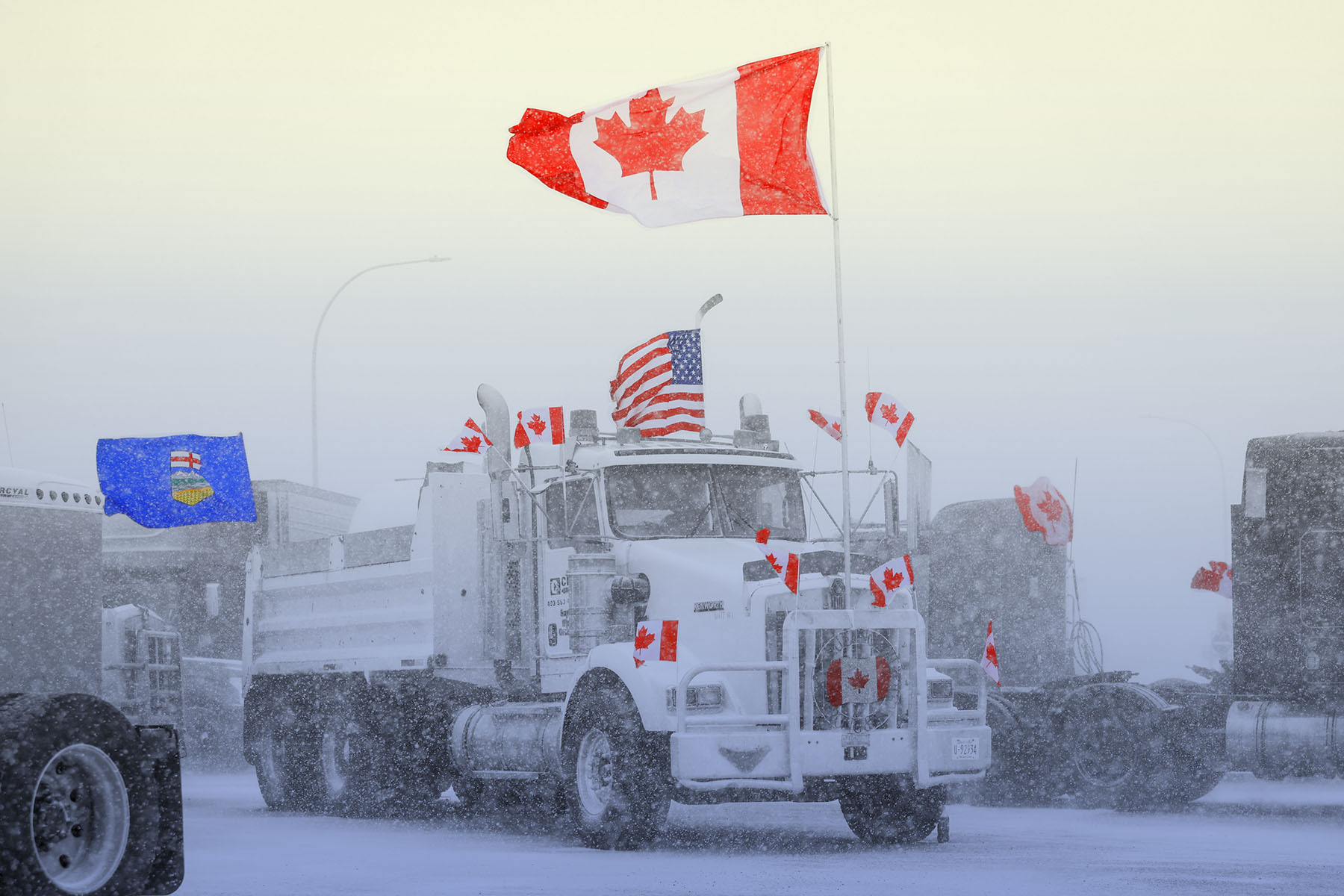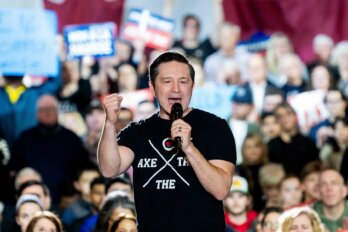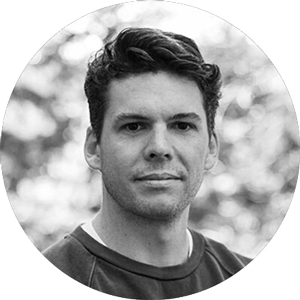The story of how Ottawa failed to deal effectively with the three-week “Freedom Convoy” protest in January 2022 is a particularly Canadian story. As with so many problems we can’t fix, it involves jurisdictional overlap that allowed officials to do nothing because they would not be blamed for doing nothing.
When Canada announced that, as of January 15, 2022, no unvaccinated truckers could cross the border into the United States, it was a major challenge to an industry that had been under intense pressure since the start of the pandemic. Many truckers had a tough time during COVID-19, when businesses closed their bathrooms to them, leaving them struggling as they did their vital work between two stricken countries. “We worked eight months with no sanitizer, no face masks, nothing, smack dab in between Windsor and Sarnia,” Brigitte Belton, a trucker from Wallaceburg, later told the Public Order Emergency Commission. “We had no bathrooms. We had no showers. We were refused everywhere we went. You have no idea what it’s like to pee in a park on your way home from work.”
Because they were deemed essential workers, carrying essential supplies to keep the country moving, truckers had not been required to be vaccinated. Most of them were, but for thousands of them—mostly people who wrongly believed conspiracy theories about the vaccines—this mandate put them in the lurch. They could stop crossing the border, but that would mean a severe pay cut. Many had to get the jab or lose their trucks. Belton, a mother and grandmother, was facing bankruptcy. She testified that she contemplated taking her life because of the trauma around the border crossings.
On November 16, Belton had a hard time crossing at Windsor after a run to the United States. She can’t wear a mask because, she says, she has been a victim of violence, and covering her face makes her anxious. At the border, she was confronted by an officer with the Canada Border Services Agency. He got fed up after a couple of exchanges, directed her to wait in a parking lot, and told her he was going to bring in the Windsor police. Frustrated, she recorded a TikTok video on her phone in which she vented all her anger: “In Canada we’re no longer free,” she said. “This may be the night where I go and ask for exile into the US, because this isn’t my country, this isn’t what my grandparents came for, being harassed at the border over a mask.”
Chris Barber, a Saskatchewan trucker, was one of many who saw the video. He contacted Belton, and they started talking about organizing a protest. Belton mentioned that she had once been stuck on the Blue Water Bridge during a CBSA union work stoppage. If CBSA agents could shut down the border, truckers could shut down a city. They had the beginning of an idea. Barber was also networking with James Bauder, who had organized the 2019 United We Roll convoy to Ottawa—inspired by the Yellow Vest protests in France—both of which had been criticized for links to far-right and racist groups. Barber was also talking to Pat King, a far-right activist and conspiracy theorist in Red Deer with a big following on social media, and Tamara Lich, who had been active with Alberta separatist parties. A loose organization started to come together.
By January 22, 2022, the trucks were rolling in two convoys, one from Red Deer and the other from Vancouver. A few days later, other convoys left Nova Scotia and southwestern Ontario. Supporters lined overpasses and held signs encouraging the protesters. Belton was touched by the support: “Canadians finally peaceful,” she said. “Canadians supporting each other.” The convoyers kept their spirits up through social media networks—and they were growing stronger by the day.
Prime Minister Justin Trudeau denounced them. “The small fringe minority of people who are on their way to Ottawa, who are holding unacceptable views that they are expressing, do not represent the views of Canadians,” he said in a news conference as they rolled toward Ottawa.
The convoyers wore his comments as a badge of honour. Belton could not believe that Trudeau was attacking people like her. “The wording that he used was division, the whole time,” she testified later. “I draw the line when my government wants to throw something into my body I cannot remove . . . Bodily autonomy, it is mine. It is not my government’s.”
Most Canadians supported the government’s agenda on COVID-19, but there were millions who did not, and they had had enough. The convoy was forty kilometres long by the time it was rolling through eastern Ontario, with throngs cheering it on. On January 28, the trucks arrived in Ottawa in a cloud of diesel smoke. The city had no idea how to respond.
Ottawa police are used to welcoming protesters, including farmers who annually park their bulky equipment in front of the Parliament buildings to remind MPs of their existence, so they helped the occupiers find places to park their vehicles and gave them an additional parking lot at Coventry Road, five kilometres away. It quickly became clear that the truckers weren’t conducting a normal protest. Unlike the farmers, they were settling in for the long haul. By noon on Saturday, January 29, the protesters had gridlocked the frozen city. Big rigs lined the streets in the downtown core, their engines running constantly, their horns honking.
Randy Hillier, the former Ontario MPP who had been leading protests against health restrictions from the beginning of the pandemic, went in for the day to join the demonstration and was so taken with the festive spirit that he checked into a hotel. “You had never seen such overwhelming friendship and love,” he told me later. “I think euphoria was the best word that I could come up with. It was festive.”
For the protesters, it was a great party, a joyful and peaceful expression of freedom and togetherness. Most of the protesters were not truckers, but many were tradespeople. They built temporary shelters and set up hot tubs for adults and bouncy castles for kids.
For residents of downtown Ottawa, few of whom agreed with the protesters, it was a sudden nightmare in their neighbourhood. Many protesters were uncouth, drunk, and aggressive, taunting the masked and refusing to wear masks in stores and restaurants. The massive Rideau Centre mall had to shut; small businesses lost their customers. Protesters danced on the National War Memorial, put a protest poster and a ball cap on the statue of Terry Fox. Staff at the Shepherds of Good Hope soup kitchen reported being harassed and assaulted.
The residents of the many high-rise buildings near Parliament Hill were constantly bombarded by the chaos in the streets, the stench of diesel fumes, and the sound of horns, making it difficult to sleep or relax. “The first thing you noticed when you stepped outside was all the snow, because services were unable to be rendered due to the occupation that was going on,” Zexi Li, a young public servant who lived downtown, told the commission. “The snow was often coloured yellow or brown due to the public urination and defecation that took place gratuitously. . . . And oftentimes there were illegal bonfires and just trash burning right next to cans of fuel or near the same areas where these individuals would later set off fireworks.”
Running errands became a nightmare, she said. “I’m a small Asian woman. I wore a mask most of the time due to the situation that was going on. It made you a target because it signalled to the people on our streets that we were not supportive of their cause and that we were not one of them. And in turn, they would increase their honking, and target their honking, and shout at us, shout at me, about how they were doing things for us and that they were fighting for our freedoms when, at the same time, I was unable to walk the streets feeling safe.”
The protesters laughed at the residents’ objections. They saw them as Trudeau voters and Liberal mandate-supporters who deserved what they got. “The honking will continue until freedom improves,” ran one slogan.
The convoy movement was steeped in conspiracism, the toxin that spread through algorithmic social media networks during the pandemic, boosted by anti-vaxers selling quack COVID-19 cures, attention-seeking wellness hucksters, antisemites, and foreign propagandists who wanted to increase discord in our society. An increasingly agitated minority was convinced that United Nations troops were being flown in to establish the New World Order, that 5G towers caused the pandemic, that the World Economic Forum was going to force everyone to eat insects. Some of them were furious, believing that politicians were in on a vile conspiracy, and their fury made them dangerous.
Ottawa was in the grip of militants who would not leave until the government handed power over to them. Bauder’s group had posted a memorandum of understanding that laid out the protesters’ demands. The document demanded that the Senate and the governor general “agree to immediately cease and desist all unconstitutional, discriminatory and segregating actions and human rights violations,” deposing the freshly elected legitimate government.
The protesters wanted a meeting with Trudeau, and well-meaning people called for the government to extend some kind of olive branch and negotiate, but Trudeau, who had contracted COVID-19 again, said no. “We are not intimidated by those who hurl abuse at small business workers and steal food from the homeless,” he said in a news conference as the protesters settled in to their expanding camps. “We won’t give in to those who fly racist flags. We won’t cave to those who engage in vandalism.”
Trudeau would not give in to the convoyers. It was a police matter, but the police could not clear the streets.
At the beginning, Ottawa police seemed too friendly to the protesters, posing for pictures and generally trying to be helpful to a group of white people whose values and beliefs they found relatable. An Ottawa Police Service intelligence report later made public described the convoyers as “a truly organic grass roots event that is gathering momentum.”
Under pressure from miserable residents, police chief Peter Sloly tried to take action, but he was stymied, in part, by front-line officers who were reluctant to confront the protesters. Frustrated, he lashed out at his subordinates, which only made things worse. Raids he ordered did not happen. He wanted more officers from the Ontario Provincial Police, but the operational plans he sent to that force were deemed inadequate, and his request went unanswered.
Ottawa was not being policed. Ticketing didn’t start for days. Tow-truck companies hesitated to move illegally parked trucks for fear of losing business from truckers after the protests ended. Protesters were refilling their trucks with jerry cans of diesel. When the police were ordered to put a stop to that, protesters began to carry empty jerry cans en masse to overwhelm law enforcement, but they needn’t have bothered: front-line officers were not following orders to stop them from gassing up. There were reports that sympathetic officers were sharing police intelligence with protesters. Anything the police did could backfire. Families with children were living in some of the trucks, and there were reports of firearms in others.
Throughout, Sloly and Ottawa mayor Jim Watson were ineffectual. Premier Doug Ford, in distant Toronto, had direct constitutional responsibility for policing Ottawa, but he sensed that the public considered the standoff Trudeau’s problem and stayed out of it. He never visited Ottawa and instead left town to go snowmobiling at his cottage.
For the Conservatives, the convoy brought a burst of energy to Parliament Hill. The city was suddenly full of people who felt about the prime minister the way many of their constituents did. An Angus Reid poll showed that the public mood was turning against mandates: 50 percent of Canadians wanted restrictions lifted, and that rose to 80 percent for Conservatives.
Conservative leader Erin O’Toole tried to straddle both sides: he couldn’t embrace the convoyers, whom he viewed as lunatics, nor could he ignore them. He met with some truckers outside Ottawa but not the convoy organizers. The Liberals still attacked him, and the freedom-loving members of his caucus criticized him. Former Conservative leader Andrew Scheer led a group of Saskatchewan MPs to meet with the convoyers to show their appreciation “for the hardworking, patriotic truckers who have kept our supply chains healthy and grocery shelves stocked for the past two years.”
O’Toole tried to keep his MPs from siding with the protesters. “Let them blow their steam,” he said. “I don’t support people breaking the law, so we can’t support this. . . . Once we get through the COVID craziness, the media focus will then be Trudeau running again. I said, get through this and we will crush the next election with the same approach we had.” They refused. On January 31, a third of O’Toole’s caucus signed a letter calling for him to step down. On February 4, MPs voted seventy-three to forty-five to end his leadership.
Pierre Poilievre was waiting in the wings.
Ottawa residents had had it. Abandoned by the police, they were tired of the noise, the fumes, and the maskless louts peeing in snowbanks.
On the day the Tories stuck the knife into O’Toole, Paul Champ, an Ottawa human rights lawyer, was introduced to Zexi Li, who was fed up with her neighbourhood becoming an outdoor toilet. Li agreed to be the lead plaintiff in a class action suit against the convoy. The next day, Champ filed a statement of claim, seeking monetary compensation for those affected by the constant honking.
Days later, Champ won an injunction not only to stop the honking but also to freeze millions of dollars in bank accounts controlled by the organizers. Spurred by friendly coverage from Fox News and viral posts on social media, donations of about $20 million had poured in, helping to pay for hotel rooms, diesel fuel, and logistics in general. The normally quiescent citizens of Ottawa had finally reached their breaking point and were pushing back. On February 13, a neighbourhood dog-walking group from Ottawa South organized a counter protest and blocked a small convoy of flag-bearing vehicles. Police pled with convoy opponents to avoid confrontations.
That same day, at the Canada–US border at Coutts, Alberta, Mounties arrested thirteen convoy protesters who had blockaded the crossing. They seized firearms, body armour, and ammunition. Four protesters were eventually charged with conspiring to murder RCMP officers. Two of them were linked to Jeremy MacKenzie, the Afghanistan War veteran from Nova Scotia who had founded the far-right group Diagolon. Every day, MacKenzie was livestreaming with his friends from the convoy compound in Ottawa.
After the Coutts bust, police moved to clear the blockade at the Ambassador Bridge, the Detroit–Windsor border crossing, which had jammed supply chains for auto-parts manufacturers on both sides of the border. Ford may not have cared about a bunch of Liberal and NDP voters in downtown Ottawa, but he would not let the auto industry get shut down. In a phone conversation with Trudeau, he promised that the Ontario Provincial Police would clear the border. “This is critical,” he told Trudeau. “I hear you. I’ll be up their ass with a wire brush.”
After that border was cleared, the province began to shift police to Ottawa, to augment the beleaguered local force. Trudeau invoked the Emergencies Act, which enabled him to take extraordinary measures to end the siege. He announced the crackdown in the National Press Theatre, flanked by Chrystia Freeland, Marco Mendicino, and David Lametti. “We cannot and will not allow illegal and dangerous activities to continue,” he stated.
The act empowered the RCMP to play a greater role in policing Ottawa, froze bank accounts being used to fund the protests, and allowed the government to force reluctant towing companies to move trucks. It also stipulated that, within a year, a Public Order Emergency Commission would have to report on whether this use of extraordinary power was justified. Interim Conservative leader Candice Bergen, who had wanted Trudeau to negotiate with the protesters, said invoking the act was a mistake: “The prime minister had the opportunity to talk and listen to so many he disagreed with, and he refused to do so, so this looks like a ham-fisted approach that will have the opposite effect.”
Poilievre, preparing to launch his leadership campaign, confidently asserted what he thought Trudeau should have done: “Real simple. Listen to the science, do what other provinces and countries are doing, that is to end the mandates and restrictions so protesters can get back to their lives and their jobs. The only emergency is the one that Justin Trudeau has deliberately created to divide the country and gain politically.”
A new partisan divide was taking shape, with health measures as the dominant issue around which everyone would have to orient themselves. That had been Trudeau’s choice. In danger of losing an ill-considered election campaign, he had polarized the electorate around vaccination mandates. His gambit worked—just barely—but it led to blowback, cranking up emotions that would have been better soothed. It even unnerved members of Trudeau’s own party.
A few days earlier, Joël Lightbound, MP for the Quebec City riding of Louis-Hébert and chair of the Liberal Quebec caucus, held a lonely news conference in which he objected to Trudeau’s rhetoric. “I fear that this politicization of the pandemic risks undermining the public’s trust in our public health institutions. This is not a risk we ought to be taking lightly.”
For public servants and office workers, the pandemic had been mostly about hunkering down at home, but for street-level workers, life was different. “I think it’s time we stop dividing the population,” Lightbound said. “Not everyone can earn a living on a MacBook at a cottage.”
Police started to clear the streets on February 19. They set up a hundred checkpoints, hemming in the area between the Queensway and the Hill, and slowly moved in, arresting some people. Protesters yelled, “Hold the line,” but they couldn’t, and slowly the police made them leave. “We are in control of the situation on the ground and continue to push forward to clear our streets,” said interim police chief Steve Bell. “We will run this operation twenty-four hours a day until the residents and community have their entire city back.”
Bell had taken over from Sloly, who had been driven to the point of collapse by the crisis and ultimately forced out. With reinforcements from across Canada, the Ottawa police finally had the resources and authority they needed. Tamara Lich and Pat King were arrested and charged. Within forty-eight hours, the streets were cleared and the state of emergency lifted.
Trudeau later testified at length at the Public Order Emergency Commission as commission counsel took him through a record of his behind-the-scenes communication with officials and politicians throughout the crisis. Calm and friendly, he was able to explain his interactions and state of mind with a thoroughness and precision that surprised viewers used to his pep talks full of platitudes and virtue-signalling warnings about extremists who don’t share Canadian values. He was accounting for himself thoroughly and convincingly. “I am absolutely, absolutely serene and confident that I made the right choice,” he said. He had acted when he had to: “The situation was out of control, with the potential for violence, not just in Ottawa but across the country.”
Nomi Claire Lazar, a political science professor at University of Ottawa and the author of States of Emergency in Liberal Democracies, believes things could have gone much worse. “I don’t think anyone can contest the fact that the situation was resolved in a way which was far safer, better than anyone could have hoped.” Lazar was a member of the research council for the commission but also lived through the convoy. “I live just two or three blocks from the cordon area—and we were really expecting that things might go badly. Everyone thought that it might become violent. The situation got resolved without anybody being seriously injured, nobody being killed. It was resolved quickly, effectively, efficiently, safely.”
Commissioner Paul Rouleau, the Ontario Court of Appeal judge who presided over the inquiry, found that Trudeau had met the “very high” threshold necessary to invoke the Emergencies Act. “In my view, there was credible and compelling information supporting a reasonable belief that the definition of a threat to the security of Canada was met.” He did, however, criticize Trudeau for calling the protesters part of a “fringe minority,” which cranked up the tension and energized them. “More of an effort should have been made by government leaders at all levels during the protests to acknowledge that the majority of protesters were exercising their fundamental democratic rights.”
However, this would not be the final word. In January 2024, Federal Court justice Richard Mosley issued a ruling agreeing with an application from the Canadian Civil Liberties Association and the Canadian Constitution Foundation. Mosley ruled that the government’s invocation of the act did not “bear the hallmarks of reasonableness.” A government “cannot invoke the Emergencies Act because it is convenient, or because it may work better than other tools at their disposal or available to the provinces,” he wrote.
Mosley noted that the protests in Alberta and at the border had been cleared by police, that Ottawa could have been managed similarly, and therefore found that the Emergencies Act had not been warranted. He also found that when the RCMP had ordered banks to freeze the accounts of protesters without due process, the government had violated Charter protection against “unreasonable search or seizure.” And by ordering the streets cleared of all protesters rather than merely acting against the law breakers honking horns and blocking roads, the government had violated the political rights of law-abiding protesters.
Both Mosley and Rouleau took care to note that the questions are difficult. “Reasonable and informed people could reach a different conclusion,” wrote Rouleau. “Had I been at [the government] tables at that time, I may have agreed that it was necessary to invoke the Act,” wrote Mosley.
The government immediately announced that it will appeal, so the Supreme Court will ultimately decide which of the two judges was correct. The question of whether the invocation of the act was justified is one for constitutional scholars, but the Mosley ruling was a blow to Trudeau, reinforcing Poilievre’s long-standing critique of his handling of the convoy. “He caused the crisis by dividing people,” Poilievre tweeted. “Then he violated Charter rights to illegally suppress citizens.”
And the invocation of the act opened Trudeau up to more intense attacks from outside Canada. Fox News treated the episode as proof that the Liberal poster boy was a hypocrite, suppressing lawful dissent with the help of jackbooted thugs. On February 21, Tucker Carlson, then the top-rated Fox talking head, warned that northern-style totalitarianism was coming to the United States: “At this point it’s pretty clear that if you want to know the future they are planning for us in the United States, look north to Canada.”
Excerpted from The Prince: The Turbulent Reign of Justin Trudeau by Stephen Maher. Copyright © 2024 by Stephen Maher. Reprinted by permission of Simon & Schuster Canada, Inc. All rights reserved.






